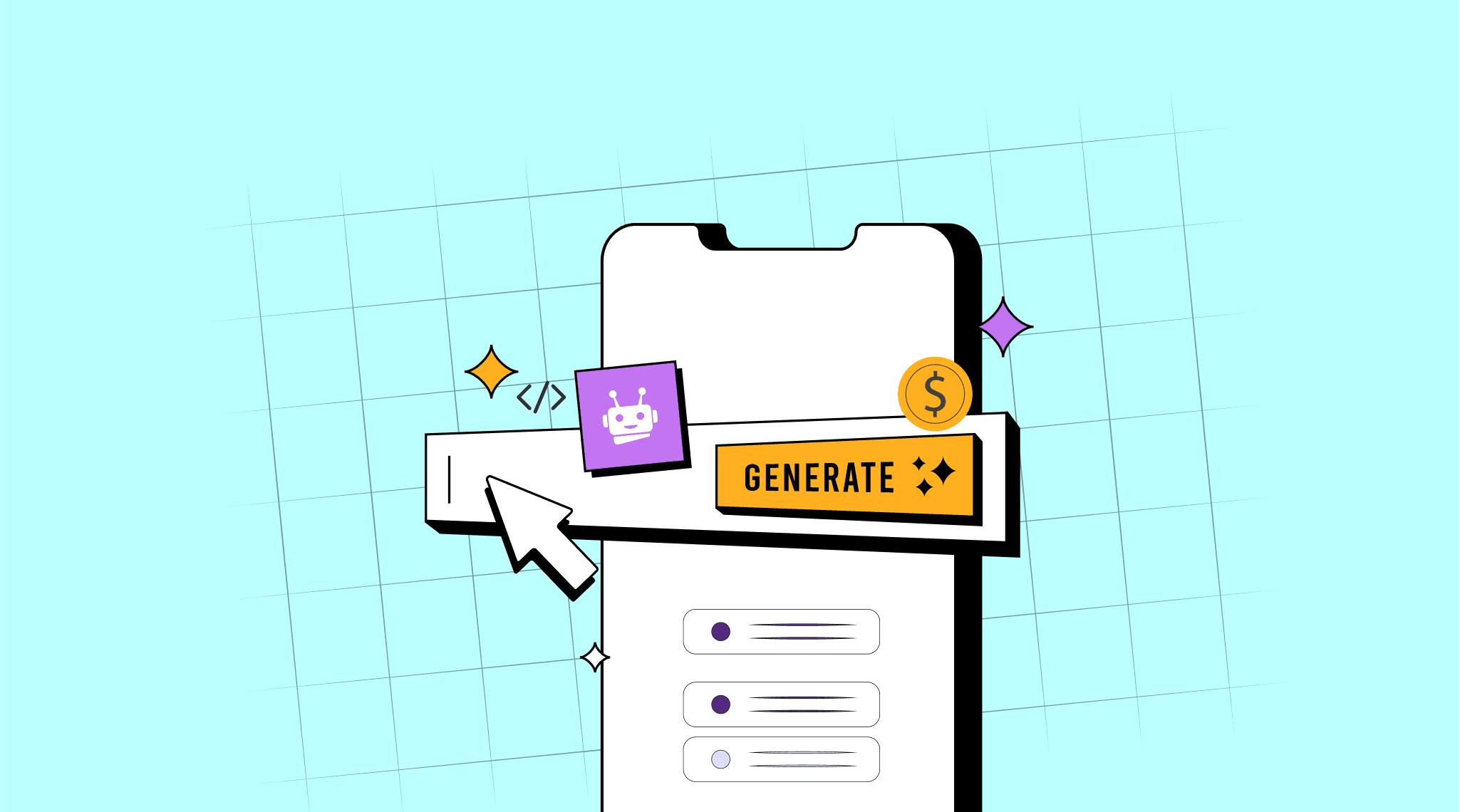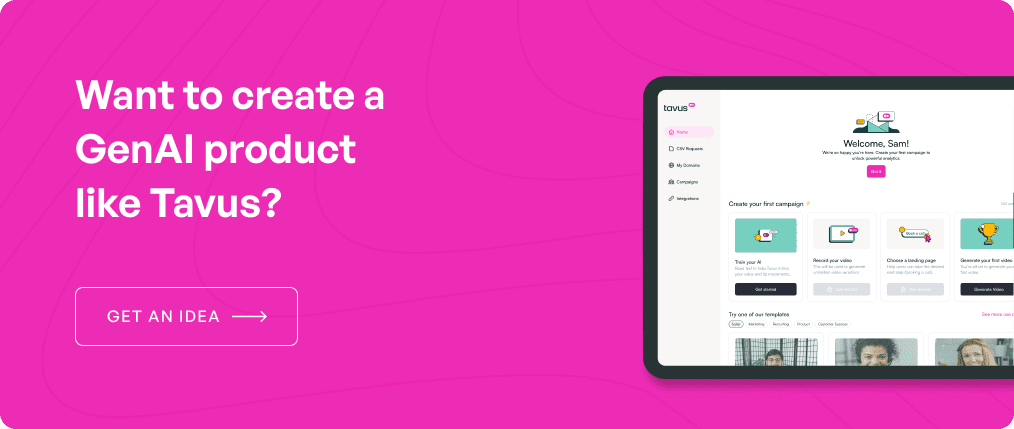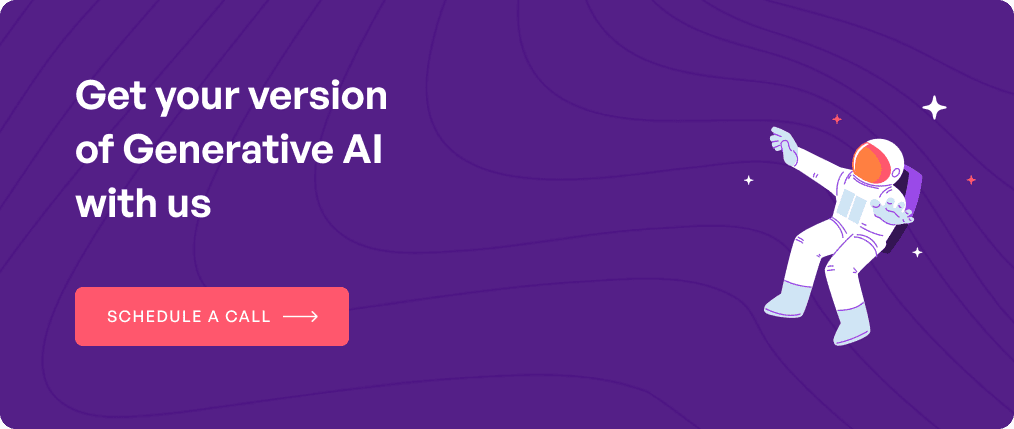GenAI is a type of AI that is sophisticated at doing what humans do. Just more efficiently and at lower expenses. It differs from conventional AI in its capability to generate fresh content that impersonates the human mind. This is why generative AI has been seeing hyperadoption in several industries on an enterprise-wide scale. Let’s understand how. GenAI holds the possibility of bringing huge data, focused on human thoughts. For instance, it can evoke joy, sadness, empathy, motivation, and nostalgia. This is extremely helpful in industries like healthcare, travel, lifestyle, and movies which sell because customers buy on emotions rather than on core logic.
Businesses have already identified the powerful benefits and know that GenAI will play a key role in shaping the future of brands. Thus, learning and investing in this technology is a viable solution to stay ahead of competitors. Talking about the investment, building a GenAI app will roughly cost you between $600,000 – $1,50,000.
In return, businesses like yours can amplify creativity, enhance efficiency, and reduce the risks of error by human resources. Ultimately, this will lead to higher levels of customer satisfaction and drive sales and loyalty.
The generative AI market is all set to explode to $1.3 trillion by the next 10 years from just $40 million in 2022 at a CAGR of 42%. So, this is the right time to build distinctive generative AI applications, something that rivals will not be able to copy. Also, companies must prioritize the responsible usage of the technology by being well-informed about its tools and limitations and increase organizational efficiency. The next section reveals the popular apps, features, costs, factors affecting the cost, and all relevant information to build GenAI.
Table of contents
Popular apps built by GenAI
GenAI focused apps aim to create fresh content which is valuable for fields like marketing, customer services, creativity or software development. A few most popular apps are ChatGPT, Lensa, Character.ai, Midjourney, Microsoft Copilot, Gemini, Synthesia, AppSheet, Google Bard, Janitor AI, ElevenLabs, Quillbot, and Civitai to name a few.
Features of generative AI
Embedding GenAI and its latest trends in your app access to multiple interesting features. These boost performance due to quick customer support, rich visuals and content, and software programming. These transformative capabilities have promising impacts on the business landscape and are worth your capital investment. Altogether, substantial enhancement of your app ultimately resonates well with your target audience. Below are a few top features that generative AI offers.

Realistic content
As we discussed before, GenAI mimics the human brain. So, it is a valuable tool for creating extremely realistic and emotional content that your customers can relate to. But how does it happen? Well, generative AI development is powered by training on structures and patterns of extensive data. Continuous interactions with these can fine-tune the output and generate human-like responses over time.
GenAI can also produce images that do not differ from real photographs using the ‘deep fake’ synthetic technology. It produces accurate replicas of the original. For instance, the algorithms combine fake audio, videos, and images to make it appear like a real individual is talking or performing similar actions.
Deep learning
Advancements in deep learning (huge neural networks with processing unit layers) have improved the performance of GenAI. This means, it is able to understand huge training data and generate new data based on it. The catch is that this learning process is unsupervised or semi-supervised which saves the precious time and energy of humans. Gen AI further uses machine learning to predict the final outcomes of an inquiry.
Tech stack
GenAI runs on several technology stacks like ML models, deployment tools, infrastructure, and programming languages. This includes Python, Julia, TensorFlow, Jupyter, Git, PyTorch, NumPhy, and Notebook. All of these combined help produce unique outputs and enable continuous refinement while mitigating complex challenges.
Multiple applications
ChatGPT, Microsoft Copilot, Google Cloud Platform, and Gemini are top generative AI applications. Businesses can consider leveraging the technology to power chatbots, content generation, risk management, automation, audience research, product development, supply chain management, 3D shape building, bug fixing, policy documentation, quality control, code review, educational course design, and solving math problems.
However, GenAI is not built to wipe out humans from the face of this Earth! It simply assists us with a superior set of algorithms and models to develop future-proof solutions that were previously unimaginable. Now, let us get into the cost of building generative AI applications.
Generative AI app development cost
The pricing will primarily depend on whether you are training a GenAI solution or opting for a pre-trained model. Further, the extent of usage, implementation approach, platform, and computational power influences the overall cost of generative AI model development.
A basic generative AI app can cost between $40,000 to $150,000 while a feature-rich app boils down to $100,000 to $400,000 or even more. Let’s learn about the basic one in detail.
Research and development
Estimated cost: $50,000 – $150,000
Expert researchers dig deep into your target end-user to get an idea of their pain points and preferences. They also analyze competitors to see what they are doing right and their limitations to be able to develop a blueprint of a far better application, accordingly. Research is typically a constant process in this journey. This phase is conducted by GenAI experts and data scientists. The cost depends on their expertise.
Collecting and processing data
Estimated cost: $30,000 – $100,000
This phase involves collecting, preparing, and processing data- the ones that will be used to train the GenAI. High-quality data means better accuracy, valuable insights, and meaningful conversations with customers. This is a critical stage of generative AI model development since improper data can lead to biased or unsatisfactory results.
After raw content has been gathered, it is heavily cleaned, formatted, and processed. This reduces the risks of AI hallucinations while optimizing the output for usefulness. After all, GenAI is only as useful as the data it is fueled by.
Infrastructure and hardware
Estimated cost: $40,000 – $120,000
The top hardware components required for generative AI development include graphics processing units (GPUs), memory systems, and dataflow architecture processors. Further, cloud platforms are also leveraged to scale the computing process. This removes the need for using physical infrastructure. Everything from predictive analytics to natural language processing is present in a safe cloud environment.
Architecture and algorithms
Estimated cost: $40,000 – $150,000
This is a rough pricing for using advanced algorithms that create realistic scenarios and improve the overall results. These use deep learning techniques to generate texts, creative artwork, images, and entire video game environments based on prompts. It is also helpful in fraud prevention since GenAI is able to differentiate between fake and legitimate transactions which is helpful for banks, credit unions, and fintechs. The cost of developing a generative AI app will increase if you demand custom model structures.
Integration
Estimated cost: $30,000 – $100,000
This helps to modernize the business infrastructure and perform time-saving tasks like analyzing vast datasets within a minimal time frame. High-end productivity and dynamic interactions are other benefits of integrating GenAI into apps.
Deployment
Estimated cost: $40,000 – $120,000
This is where technical prowess, GenAI expertise, and experience of developers come together for successful deployment. The major parts of this process include model selection, prototype development, architecture solution, and prototype development. This is quite a critical stage and requires careful problem-solving and strategic planning.
Testing and validation
Estimated cost: $20,000 – $80,000
Security and performance, data quality, functional, and crowd testings are done when creating a GenAI solution. These are mandatory to ensure the effectiveness, validity, and reliability of the final product. Lastly, it is also validated against real-world data so that the end users receive their desirable outputs without double thoughts.
Compliance
Estimated cost: $30,000 – $100,000
This is the cost of ensuring the solution adheres to privacy laws. This includes GDPR, EU AI Act, Algorithmic Accountability Act to name a few AI regulations. The compliance parameters include transparency, duration, purpose limitation, lawfulness, and protection. Privacy solutions are further mandatory to meet competitive benefits and AI innovations.
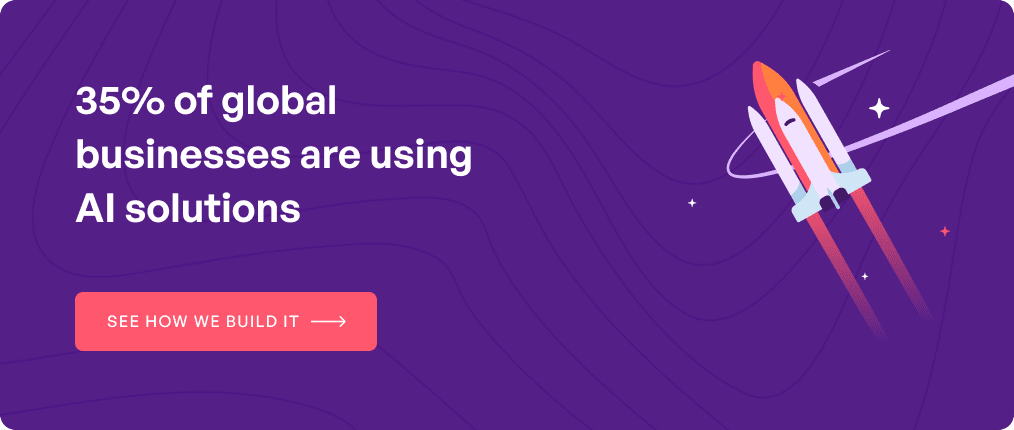 This is altogether the cost to build a generative AI model. It is a good idea to keep a considerable amount apart from these, to accommodate last-minute changes or trials.
This is altogether the cost to build a generative AI model. It is a good idea to keep a considerable amount apart from these, to accommodate last-minute changes or trials.
How to maintain a GenAI app?
Apart from building the app, developers make efforts to maintain it as well. This will include updating security patches, optimizing the code, identifying areas of improvement from client and customer feedback, and upgrading the interface to boost the overall health of the application. The ongoing costs for these would be around $40,000 to $1,00,000. Updates and bug fixes are priced separately at approximately $50,000 to $150,000.
Launching a GenAI solution in-house can be quite challenging. The process is slow and risks privacy and security. This is where Simublade can help you. We create well-strategized generative AI solutions to help you achieve your business goals at 3X speed.
For instance, we revolutionized Tavus into a software equipped with advanced cloning technology to generate AI-powered hyper-personalized videos. This was done by following a robust research process, identifying the existing gaps, building a user persona, creating wireframes and tackling product challenges like transitioning from dark mode to light mode. Other aspects we worked on were UI design, color and typography, and buttons and components. Ultimately, it turned out to be a multi million dollar company.
Our expertise also lies in AI development services like building images, videos, music, and chatbots that talk naturally. The integration and execution strategies we use are fail-proof and future-ready to boost ROI. When working with us, know your app development process is in safe hands.
Factors affecting the cost of generative AI development
Several factors control the cost of building generative AI applications. Having an idea beforehand will help set the budget accordingly. Here’s a look.
Algorithm and model
If you consider cutting-edge algorithms with unique techniques and advanced capabilities, the price to build the GenAI solution will be higher. For instance, OpenAI’s GPT-3 incurs substantial expenses of up to $4 million since it is a large language model. The time of training is approximately 9 days which further increases the training costs. The type of model (custom-trained or pre-trained) is also a factor in determining the cost of building generative AI applications.
Content type
The type of content you want your app to generate influences the overall estimation. This will include texts, audio, and video along with their complexity and scope. Datasets will be collected and processed and the GenAI will be trained accordingly. All of these are considered when arriving at the final generative AI app development cost.
Developers’ expertise
Engineers, data scientists, researchers, and GenAI experts come together to build the application for you. The experience, skills, and expertise can determine the cost of the generative AI application. However, our USP at Simublade is to take time to understand your needs which helps us offer the best possible solution within your budget. This is despite possessing impressive capabilities in the operational framework of GenAI solutions. Rest assured your app turns out to be highly functional.
Platform used
In the GenAI landscape, a platform does not mean a virtual environment to run software programs. It simply means the data set with insights that manage significant risks to create trusted AI systems. Platform also means a collection of tools and technologies to develop, test, and run ML and deep learning models. The generative AI app development cost will depend on the type you pick: enterprise, cloud, or data analytics platform.
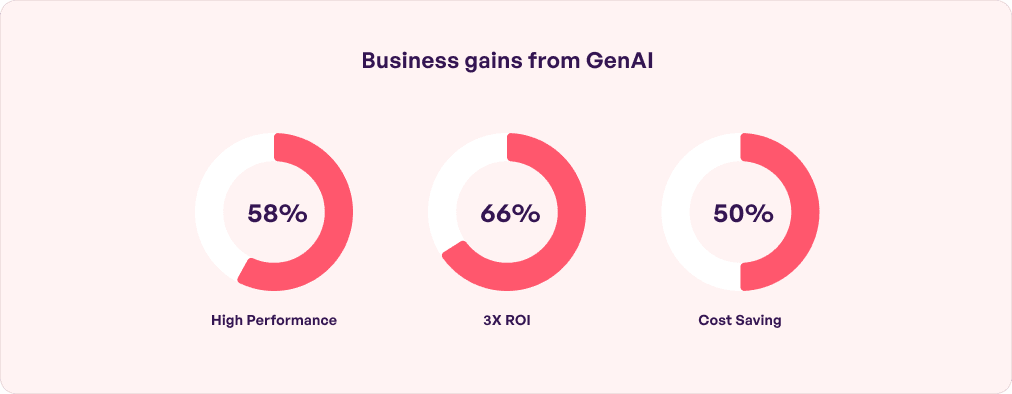
Challenges of generative AI development
Like all technology, generative AI has its bottlenecks. For instance, sophisticated data is required to train the GenAI solution for contextual relevance and accuracy. It is also necessary for the consideration of end customers, transparency, and information quality. Finding such data without inviting ethical litigations and lawsuits and maintaining data ownership and licensing can be quite a challenge.
Further, LLMs must have the ability to go beyond just keyword grasping and figure out the intent behind an input. In short, achieving a blend of both technical capability and imitating human expertise is a must to ensure a top-notch AI product.
GenAI software also faces integration challenges since new LLM technologies are less likely to be compatible with outdated computers.
Types of GenAI models
There are 4 types of models to build a GenAI product.
Generative Adversarial Networks (GANs): Two neural networks, a discriminator and a generator, contest with each other via deep learning methods to ensure authenticity and precision in their predictions. GAN architectures are especially powerful when generating images. They create synthetic data by accurately mimicking a real one. So, this makes it hard to identify a fake image which is quite an exciting innovation.
Variational Autoencoders (VAEs): This utilizes an architecture that has an encoder-decoder structure. It helps to learn any underlying structure of the user prompt. Finally, it uses deep learning techniques to generate never-seen-before data. However, the result is not fully new. It is simply a modified version of what was learned previously.
Diffusion models: This is gaining traction in outperforming the previous two models. It includes: forward, reverse, and sampling procedures. This means, it adds noise to data and then reverses it to see the new output. This is a way to determine the probabilities of different outputs that a GenAI application might generate.
Transformer-based models: This is a prominent framework of deep learning models that have revolutionized natural language processing. A well-known example of a transformed-based model is GPT-3. The learning and response are solely based on the inputs by the end user. This is made possible with extensive training and fine-tuning. In short, it is a paradigm shift in NLP, navigating the complications of conventional neural networks.
If you are wondering how to get started, talk to us at Simublade. Our AI development services include wide verticals like PoC development, custom AI development, AI integration and deployment, automation-based solutions, and AI strategy consulting. Get in touch to start building your version of GenAI application.
Top industries impacted by GenAI
Gen AI is making a phenomenal impact on different industries by accelerating substantial productivity gains. This includes fintech, healthcare, Saas, manufacturing, retail, entertainment, education, life sciences, marketing and design, cybersecurity, and supply chain management to name a few. Corporates are also embedding GenAI extensively in their systems. A net of 33% of employees and employers see benefits of better productivity and ways of working.
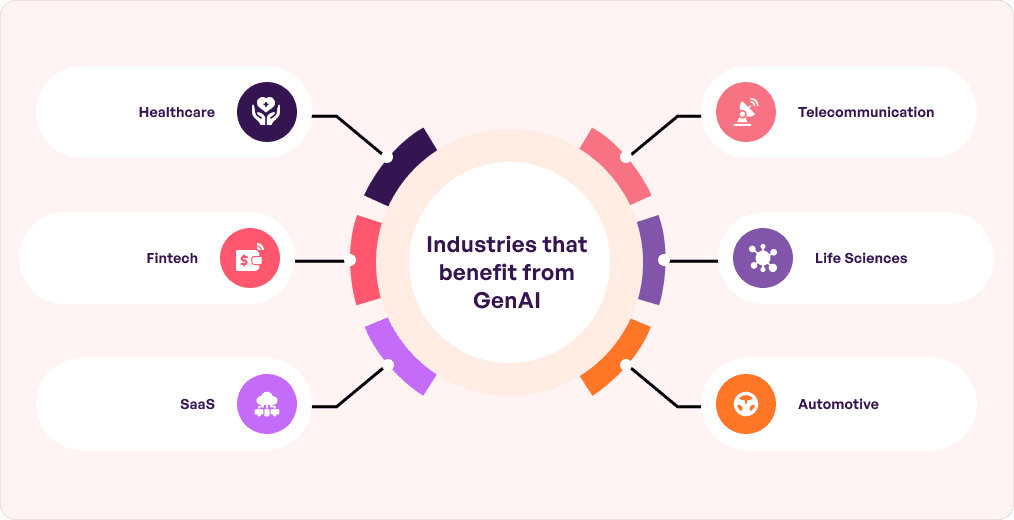 Now, let us discuss the top industries that are using artificial intelligence to improve user experience.
Now, let us discuss the top industries that are using artificial intelligence to improve user experience.
Healthcare
GenAI is being used to improve accuracy and speed with high-end healthcare apps. A few verticals where this technology plays a major role include diagnosis and treatment, clinical trials, analysis of huge datasets, investing opportunities in new drugs, identifying health threats, and summarizing data for healthcare professionals. Given the potential, 75% of leading healthcare companies are planning to scale the usage of GenAI or are already experimenting with it across their enterprises.
Fintech
GenAI is undoubtedly reshaping the financial space. Here’s how. It plays a key role in intelligent document processing, monitoring transactions, identifying investment opportunities, detecting suspicious activities, powering AI-based call centers, offering impeccable customer service and experience, performing repeated tasks like data entry, managing payment processes, and improving the capabilities of existing software. Overall, it is a good idea for entrepreneurs to invest in fintech software to upscale and transform their enterprises with data-driven insights.
SaaS
The right AI-powered SaaS product can be leveraged for intelligent automation, creating new content like text, images, and music, preparing data samples, and excellent personalized experiences. GenAI can also help speed up the software development process which sets companies apart from the crowd and leads to stakeholders’ satisfaction. Overall, it is a paradigm shift in the way the SaaS industry previously worked.
At Simublade, we offer all the above services with highly advanced tools and techniques mixed with the unmatched skills of our technicians. Further, we make sure there are minimum security risks for data that is inherently sensitive.
How to integrate GenAI into existing systems?
Developers have an immaculate understanding of generative AI model development and its integration. So, this section is for entrepreneurs to ensure they have a clear idea too. Merging GenAI into existing software frameworks means taking several factors into account and adhering to the compatibility guidelines. Here’s an outline of what should be done:
Step 1: Identify the business problem that you require the GenAI solution to solve for you. For instance, better customer support or app customization. Know that generative AI is mostly used for creative tasks via prompts.
Step 2: Pick the right development team of data engineers, UI UX designers, and software developers who can help with AI app development services like integration in your operational software. They will make sure your ongoing process is efficient. This ensures high productivity, profitability, and a fail-proof end result.
Step 3: Allow this team to collect and prepare data, test it thoroughly, train and refine the models, and finally integrate it into your system. However, the work does not end here. It is optimized and monitored in real-time to ensure the GenAI solution is performing well without bugs and similar hiccups.
This practice of integrating preferred or custom AI into existing platforms is known as Bring Your Own AI (BYOAI). This is a good way to ensure efficiency and alignment with goals.
Cost of integrating GenAI into an existing system
The cost to build a generative AI model and integrate the same depends on the level of complexity. A high-level complex AI costs $80,000 to $100,000, a medium-level complex AI costs $40,000 to $60,000, and a low-level complex AI costs $15,000 to $30,000. The overall expense will depend on the intricacy of the model, data type, and core features, and performance of the algorithm. Further, maintaining the software will incur separate costs.
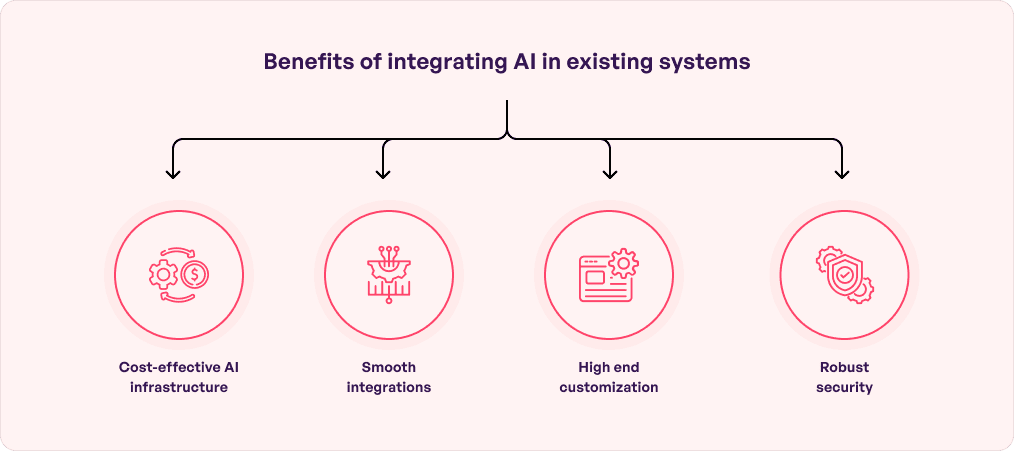
What are the latest GenAI trends in tech to stay ahead?
Multiple trends have been fine-tuning GenAI since its inception. Here’s a look at the best ones that will influence its capabilities in years to come.
Conversational
GenAI chatbots can help offer a conversational interface. This is made possible with natural language processing and machine learning techniques. A combination of both ensures the GenAI software can accurately read human inputs like texts, codes, images, audio, and videos. The bots can further mimic human language and respond in the most genuine way with an interactive and problem-solving approach.
Open-source wave
Open-source models are an effort towards ensuring shared knowledge while fostering creativity and innovation in the AI ecosystem. This means getting your hands on diverse ideas and contributions, just like Elon Musk’s GenAI bot Grok. The cost to build a Grok-like generative AI application will depend on this ‘open source’ factor to an extent.
Hyperpersonalization
Generative AI has the ability to analyze and understand a sea of data. This helps it to adopt user preferences and predict the same later to help entrepreneurs get dynamic multimedia content. Altogether, GenAI offers highly granular products and services.
Multimodality
Like we discussed above, GenAI can combine multiple types of inputs to generate creative responses. This is done by intermingling one with another. For instance, generative AI applications can turn a text into a song or a video into text. This is completely original and makes the bot capable of handling complex user queries and conversations.
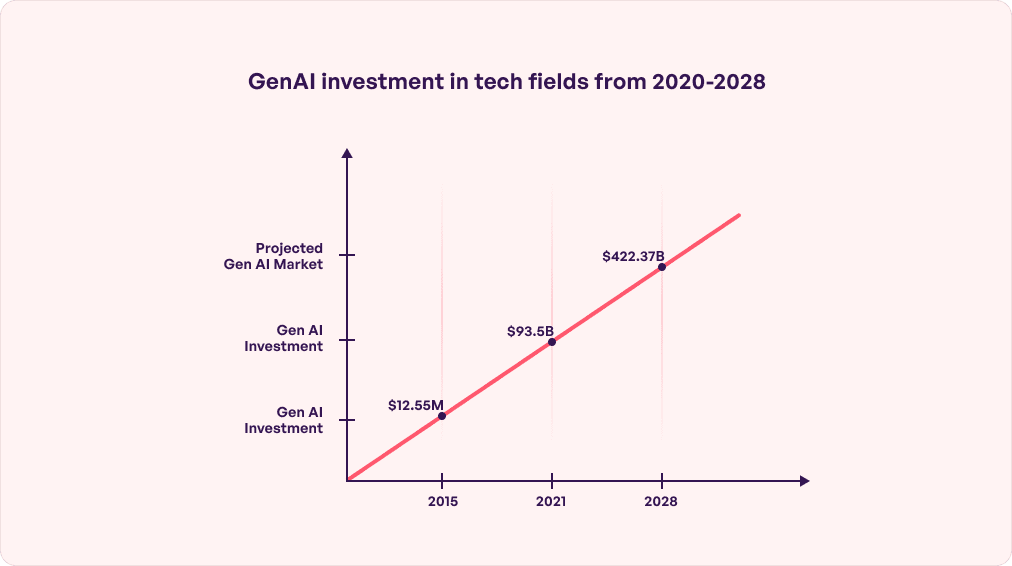 Despite GenAI progressing at a fast pace, humans must be kept in the loop to ‘think’ and ‘strategize’ along with making sure there are no artificial intelligence hallucinations.
Despite GenAI progressing at a fast pace, humans must be kept in the loop to ‘think’ and ‘strategize’ along with making sure there are no artificial intelligence hallucinations.
FAQs
Q. How long does it take to develop a generative AI model?
Ans. Generative AI development can take 3-36 months depending on factors like complexity, usage, and scope.
Q. How much does it cost to make a generative AI?
Ans. The cost of building generative AI applications is between $6,00,000 to $150,000. It depends on several factors like platform, models, developers’ expertise, and the type of content you want to produce.
Q. Why choose Simublade for Generative AI App Development?
Ans. Simublade offers generative AI development services in the US by highly qualified and experienced technicians. We are constantly growing with the ever-evolving AI by learning and running tests for every new algorithm, tool, and technique. This helps us stay upgraded and help companies at every step of the generative AI model development.
Q. How much does it cost to maintain a generative AI app?
Ans. Ongoing maintenance of generative AI applications can cost between $40,000 to $100,000 and updates and improvements can cost between $50,000 and $150,000.
Q. Are there any legal implications to be aware of when deploying Generative AI systems?
Ans. While in the process of generative AI development, developers need to be careful regarding confidentiality and data privacy. Companies, on their part, must adhere to GDPR and CCPA.
Q. What programming language is used in generative AI?
Ans. Python is the primary programming language of generative AI model development. Others are Prolog, C++, Java, and R.


